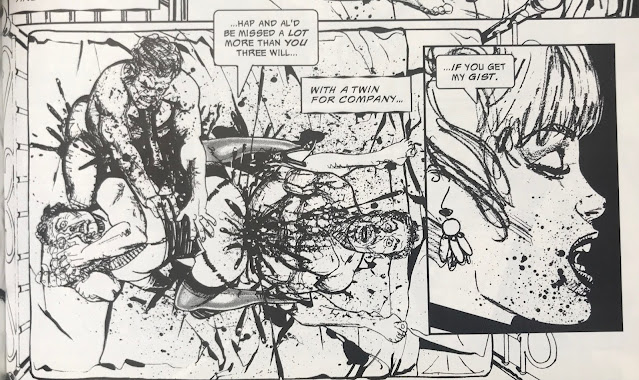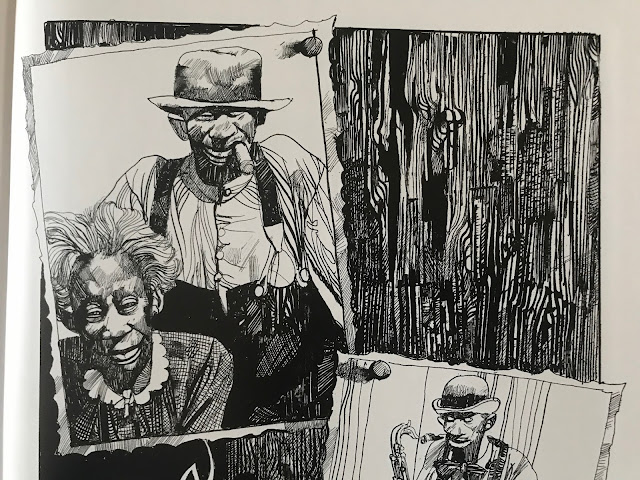Hellboy in Hell, Omnibus vol. 4, by Mike Mignola
2018
Sometimes I just want to review a comic, and sometimes I have a hot take: Hellboy in Hell is the closest I've seen a mainstream comic come to applying Chris Ware's techniques.
Up front, yeah, I know the Dave Aja issue of Hawkeye where he copied Chris Ware, but that was a straight single issue homage, not an omnibus collection.There are six Hellboy omnibuses, the first four of which make up the main saga, and two more which have odds and ends. I ended up starting with book three and have read this one, book four, which acts as a conclusion.
I liked it but I don't think I'll be buying more of these books at full price. Or maybe I will for ones that Mignola draws himself. I've been spending a lot and need to think about my purchases. The thing is, I bought the original Hellboy Seeds of Destruction issues in the 90s and dropped off them because the story wasn't what I wanted, and here too, the story was beside the point. That said, twenty years had passed between when Mignola drew that story and when he drew Hellboy in Hell, and it seems like he's gotten better. I don't know. I loved his work from the start when I saw it in Rocket Raccoon and his work across Marvel on odds and ends. And I bought Gotham by Gaslight off the stands. But I haven't sat down with his work and given it much thought in twenty years. So maybe the stuff I'm going to talk about here is applicable to his old work. But the work here seems to come from an artist who's been doing the daily practice of art for decades, and is working from his mind rather than a concrete script.
And the book is all the better for it. This is definitely a case of it not what happens that makes it good, but how it's told.
 |
| The lower left and upper right panels bleed off the page, the lower left one showing something tucked away in the town, the upper right showing the sky just outside the town. The girl in the window, the family portrait, and the corpse and snake act like mini-sequences within |
The story is: Hellboy has died and he's gone to Hell. Hell in this case is conceived as different layers of existence, ending with a city ruled by demons on a lake of fire. Something like that. He throws out lots of mythology, and I got the gist of it, but it was the least interesting part of the book. Hellboy disrupts this by being the one to rule Hell and lead... Anyway, Hellboy has no interest in it. In another book, I'd hate this all with a passion, but as Mignola tells it, it's a kind of gothic prog-rock poetry.The feeling I was left with at the end was of the musicality of it all. While there is distinct storytelling going on, pages are interspersed with images to create ambiance and rhythm. Mignola uses a technique where pages are drawn on a grid, with no diagonal panels that I noticed, and usually one "framing" panel that bleeds off the page. Within the page, he often uses blocks of panels of one theme, like mini sequences within the larger sequence of the page.
 |
| The cat growing in size from panel to panel is a hard thing to convey |
These sequences are accented by Dave Stewart's color (who I was praising only days ago for his Daredevil work). I get why Mignola's name is the one on the cover, but Stewart kind of should have been on there too. Flashbacks are used throughout and Stewart's color in these sequences help create a rhythm.
 |
| Ten panels on the page, five of them silent |
As I finished the main story, I was a little surprised. The "climax" happened in captions and a few images, rather than bloated sequences. Then the story tapered into a denouement of Hellboy on an overcast beach and entering a house. It all felt pretty abstract for an action book. It had a feeling of musicality.
 |
| The second and third panels without a gutter to signify a flashback was a neat little technique |
Mignola has some notes at the end of the book where he states he had more issues planned, but as he was coming to the end, he felt it was ready to be wrapped up. And I could see that for the sake of the story, he could have shown more of the end of Hell, but I got what he meant. Hellboy had experienced and learned what he was going to in the story, and the stuff he yadda-yadda'ed over was to resolve a story, but not necessarily going to make it more satisfying to see in action.
 |
| A four-page sequence mid-story is done in a watercolor style, and reads like the eye of the (quiet) storm |
With Chris Ware, I read interviews with him decades ago where he stated two things: that comics had rhythm and that he let his pages go where they naturally seemed to go. His work can be criticized as boring, and if you're looking for a standard plot with a resolution in his books, you will likely be bored. His pages are about the rhythm and the experience. I think that's where Mignola has gone with his storytelling. He has made a lot of space in his comics to give the atmosphere its own panels. While a lot of panels give story progress, a lot of them don't. A lot of pages would tell the content of the story with multiple panels removed.
 |
| In this sequence, the top left panel on right page has no story-driven reason to exist |
Of course the content of the story is important to, to give the reader something to grasp, but having so many superfluous panels creates a more spacious atmosphere, and makes the comic more than merely a story delivery system. It gives you the space to really enjoy the comic form itself.I really liked this, and my curiosity is to see if this is what Mignola was already doing 20 years ago, like in the Jungle Adventure or Seeds of Destruction. He may well have and I was not that clued into the nuance of how stories were told back when I first read them. I have to imagine that he was somewhat more conventional in his storytelling. With those original Hellboy, he didn't trust himself enough to script them by himself, and he was building up confidence as a writer. With Hellboy in Hell, he had the confidence to substantially change his plan mid-story because of what felt right. He went with the rhythm of the story.
























































